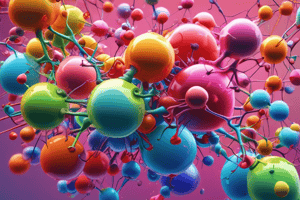Podcast
Questions and Answers
What is the function of phosphoglycerokinase?
What is the function of phosphoglycerokinase?
Phosphorylate phosphoglycerol at the expense of ATP
If a molecule is oxidized, then the molecule lost an electron.
If a molecule is oxidized, then the molecule lost an electron.
True (A)
Which of the following molecules is reduced?
Which of the following molecules is reduced?
- ATP
- FADH2
- NADH (correct)
- NAD+
Which molecule is higher in energy when electrons move from NADH to NADH oxidase?
Which molecule is higher in energy when electrons move from NADH to NADH oxidase?
Flashcards are hidden until you start studying
Study Notes
Metabolism and Redox Overview
- Phosphoglycerokinase is an enzyme responsible for phosphorylating phosphoglycerol.
- The phosphorylation process utilizes ATP, converting it to ADP in the reaction.
Oxidation and Reduction Concepts
- Oxidation occurs when a molecule loses one or more electrons, resulting in a higher oxidation state.
- Reduction refers to the gain of electrons by a molecule, lowering its oxidation state.
Key Molecules in Redox Reactions
- NADH is a reduced form of nicotinamide adenine dinucleotide (NAD+), carrying high-energy electrons.
- In redox reactions, NADH serves as an important electron donor, contrasting with oxidized NAD+.
Energy Comparison
- When comparing energy states, NADH possesses higher energy compared to NAD+ after it transfers electrons to NADH oxidase.
- This energy difference plays a critical role in metabolic pathways and cellular respiration.
Studying That Suits You
Use AI to generate personalized quizzes and flashcards to suit your learning preferences.




